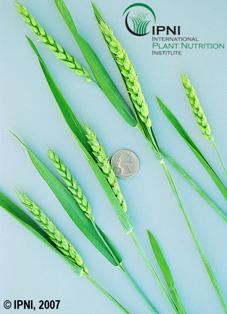Wheat
Adaptation
- Entire state. Not tolerant of soil acidity.
Establishment
Seed in late August-October. See Establishment of Cool Season Annual Grasses for more details.
Recommended Varieties†
Early: AGS 2024 and AGS 4023
Late: 30-06, AGS 4043, and Johnson (P)
Season Long: AGS 2024 (UC, LC), AGS 4043, Johnson (P)
Dyna-Gro Plantation, *Pioneer 26R10 and *Pioneer 26R41 have performed well in the past but has not been recently evaluated. No varieties have been recently tested in Limestone Valley.
†Recommended varieties have consistently demonstrated above average yields in UGA variety trials. Other varieties may provide satisfactory yields but were either not consistently above average or were not submitted to the Statewide Variety Trial program.
*More susceptible to foliar disease. Avoid planting outside recommended window.
M = Mountains; P = Piedmont; UC = Upper Coastal Plain in USDA Zone 8b; LC = Lower Coastal Plain in Piedmont; No note indicates the variety is recommended statewide.
In-Depth
 Wheat is a winter-hardy small grain that provides forage in late fall (some varieties), early winter, and spring and is well-suited to grazing or silage. When ensiling wheat, cut the crop in the late boot to early bloom stage of growth. For best results, wilt the crop to 65 – 75% moisture (25 – 35% dry matter) before chopping and ensiling.
Wheat is a winter-hardy small grain that provides forage in late fall (some varieties), early winter, and spring and is well-suited to grazing or silage. When ensiling wheat, cut the crop in the late boot to early bloom stage of growth. For best results, wilt the crop to 65 – 75% moisture (25 – 35% dry matter) before chopping and ensiling.
Wheat that has been planted for grain production can be grazed in late fall and winter without substantial losses in grain production. However, it is critical that the animals are not allowed to graze (cut) the growing point. Therefore, animals should be removed before the wheat starts to joint (usually early March in south Georgia and mid to late March in north Georgia). Wheat works well in mixtures with other small grains, ryegrass and clovers.
Establishment of Wheat
Establish wheat on well-drained, fertile soils when possible. If the sites are somewhat poorly-drained, ryegrass will be a better choice than wheat or the other small grains. Treat small grain seed with an approved fungicide prior to planting. Seedling diseases such as Phytophthora, Rhizoctonia, Pythium, and others reduce stands when planted in the warmer months of September and October, especially in south Georgia.
Wheat can be seeded between late August and early October in the Limestone Valley/Mountains region, early September and mid- to late October in the Piedmont region, and late September to late October in the Coastal Plain region. If late fall and early winter grazing is desired (lower Piedmont and Coastal Plain regions only), plant at the earlier dates of these ranges and into a prepared seedbed. Do not overgraze these pastures during the late fall or early winter. For best results, maintain at least 2 ½ in. of stubble height.
If planting into a prepared seedbed, prepare the seedbed two to three weeks before planting, if practical. This will allow the soil to settle and firm, thus improving seed germination and seedling development. Although deep soil preparation is not necessary for the grazing crop, deep tillage may benefit row crops planted in the spring.
Seed can be placed more precisely with a drill or cultipacker seeder than by broadcasting and disking. When seed are broadcast, increase the seeding rate by 25 – 30% to allow for variable seed placement. Plant small grain seed 1 – 1 ½ in. deep in moist soil. If ryegrass is in the mixture, do not plant ryegrass seed deeper than ½ in. When planting mixtures of ryegrass and wheat, it may be easier to control the seeding depth of these species by broadcasting ryegrass seed and then drilling the small grain seed into the seedbed.
Apply 40 – 50 lbs of N per acre at planting or soon after the plants emerge to increase growth, tillering (thickening of the stand), and provide earlier grazing. A second application of 40 – 50 lbs of N per acre should be applied in mid-winter to increase winter and spring forage production. Because ryegrass is longer-lived, a third application of 40 – 50 lbs of N per acre may be needed in early spring when ryegrass is used with wheat for late spring grazing, hay, or silage crop. Rates of N in excess of these amounts may result in substantial N losses to leaching and excessive growth during the winter. Fresh, tender growth that occurs when nitrogen is in excess could be damaged by extremely cold weather.
Dr. Dennis Hancock
Forage Extension Specialist
Crop & Soil Sciences Dept.
